The Palace Control Panel Interface

Your Palace has a simple graphical interface. This control panel appears on your screen when you launch your Palace.
The Palace Control Panel Interface
This chapter has the following sections:
The control panel
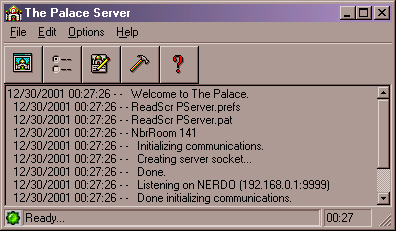
The Palace Server control panelThe control panel has several sections:Menu bar. These menus are described in Menus.
Button row. These buttons are described in Buttons
A large scrolling textbox (the Log Panel). This displays important information regarding the operation of your Palace, the network, and all users currently logged on.
Status Indicator. This tells you if your Palace is running correctly. A green light means your Palace is running. A red light indicates errors.
Menus
File
The File Menu options maintain Palace records.
Choosing this option opens a dialog box that prompts you to supply the name of the Log File you wish to create (a date-based default name is provided).
NOTE: The Log kept by your Palace site is not the same as the Log kept by the log in your client window. It records only the network-level information which appears in the large scrolling text area of the control panel, not room-level activity or speech (such as appears in the Client Log Window).This menu command closes the Log File. This command is only available if the Log is currently open.
If you didn't register your Palace during installation, you can do by selecting this option, and filling in your name and registration code in the resulting dialog box. This registration code was generated and emailed to you during the download process.
If you do not register your Palace, your Palace does not get listed in The Palace Directory.
This menu command shuts your Palace site down.
This menu has the following options:
This command allows you to copy selected text from the textbox. The hotkey combination for this command is Control-C.
This command clears the contents of the textbox.
This menu has the following items:
This displays The Palace Server Preferences window. Selecting this item is the same as clicking the Preferences button. See Preferences for more information.
Select this option to start your Palace client and connect to your Palace. Which client starts (The Palace Viewer or The Palace User Software) depends on what you set in the field The "Visit This Palace" button should.... Selecting this option is the same as clicking the Enter My Palace now button.
Select this option to load your Palace Site Administration page (described in Maintaining your site page in The Palace Directory). Selecting this option is the same as clicking the Info Administration Page button.
Select this option to launch a web page from which you can access The Palace Authoring Tool. You use this tool to customize the look and feel of your Palace. Selecting this option is the same as clicking The Palace Authoring Tool button.
Buttons
The buttons on the button bar include:
Click this button to start your Palace client and connect to your Palace. Which client starts (The Palace Viewer or The Palace User Software) depends on what you set in the field The "Visit This Palace" button should....
The Preferences button displays The Palace Server Preferences window. See Preferences for more information.
The Info Administration Page button loads the Info Administration Page for this Palace into the web browser. You uses this page to control the information about your Palace in The Palace Directory. See Maintaining your site page in The Palace Directory for more information.
This button launches a web page from which you can access The Palace Authoring Tool. You use this tool to customize the look and feel of your Palace. See the documentation with this tool for more information (available on The Palace website, www.thepalace.com).
The Help button loads the Palace help documentation into the web browser.
Preferences
Use this page to set general information about your Palace.
The Palace Server Preferences General pageUse this page to set general options.
Visitors
- Palace Name
This is the name of your Palace. This is the name that is registered with The Palace Directory.
Your Palace name directly affects users logging on through the standalone Palace User Software:
- Your site name is added to their list of recently-visited Palaces (this list is automatically compiled).
- In addition, The Palace uses this name to create a folder on their machines in which your sounds and pictures are stored (this folder will be called Palace rootMediaserverName ). If you change your Palace name after going online, your users will have to rename this file or re-download all of your media. This is not an issue for The Palace Viewer users, since it uses your Web browser's cache to hold this media.
- The Palace Configuration
The Palace provides several standard templates you can choose from to customize the look of your Palace. These template files are all available to download from The Palace website (www.thepalace.com); they are in the format templatename.pat. When you install your Palace software, you choose an initial template. To change the look of your Palace (for example, to change from a business office look to a beach resort look), you can download another template, and specify the template's configuration file (.pat) in this field. These files generally reside in the psdata directory.- Capacity...
- Allow no more than x avatars in this palace at a time:
- Allow no more than x avatars in any room at a time
- Periodically purge props (avatar accessories)..
Check this field to purge avatar props from other users that can clutter your Palace site. You can set a date after which props are automatically purged.- Keep a log of all conversations.
This lets you maintain a chat log of events and conversations happening in your Palace. This is stored in /palace/logs/date chat.log.- Allow users to whisper to each other.
Whispering lets a user have a private conversation with another user.- Allow users to make word balloons appear anywhere on screen.
If you check this field, users can "spoof". Spoofing lets a user "throw" their word balloon anywhere on the screen using the @x,y message command (see The Palace User's Guide for more information). This can be a major cause of disruption, and is not allowed at many sites.Use this screen to set privileges for the people who visit your Palace.
The Palace Server Preferences Visitors pageThis screen has the following fields:
Network
- Registered Users can...
Use this field to set various options for registered users visiting your Palace.- Allow client scripting..
When checked, this field allows members to run their own scripts (via Cyborg.ipt) while logged into your Palace. For more information on Cyborg.ipt and its uses, see The Palace User's Guide and The Iptscrae Language Guide on The Palace website. Consider that many members of The Palace community have gone to great lengths to develop creative and practical scripts. Rather than using this command to disable scripts on a global basis, consider disabling them on a room-by-room basis instead (through the Room Info option on The Palace client's Wizard menu).
- Client scripts can kick off users.
If you check this, your Palace will ignore a kill command executed from a client script.
- Allow operators (wizards)
This option determines whether or not your Palace accepts the password you set for operators (formerly known as wizards). Operators are "power-users" that can do special functions; see Owner and operator commands for more information. If this option is not checked, your operators cannot access their special menus or perform operator commands while on your site.- Guests (unregistered users) can visit my palace
When checked, this option allows unregistered Palace users ("Guests") to connect to your Palace site. If not, unregistered connections are refused. Guests have most of the capabilities of other users, but cannot wear props nor custom avatars. You can limit the number of guests by setting a number for the guest counter.Use this screen to set network preferences for your Palace site.
The Palace Server Preferences Network pageThis page has the following fields:
Security
- Let me specify a port for connecting to this palace...
This lets you set the port number your Palace uses to listen for connections from Palace clients. The default is 9998. Generally, you do not need to change this. If you do, consult your machine's administrator for available ports on your machine.- Use an external web server for media...
By default, your Palace installation contains a built-in mini web server. All of the artwork and sounds for your site reside on this server. You can keep this media in this location, or move it to a web server of your own. If you use another web server, enter the URL of the new media location here. See Art and sounds for more information.Use this screen to control security settings for your Palace site.
The Palace Server Preferences Security pageThis page has the following fields:
The Palace Viewer
- Owner Password:
This option allows you to set the password that grants owner-level access via the standalone Palace User Software. The Palace owners are superusers; they have all the privileges of operators, and even more. For example, owners are able to permanently kick people off the system, enter locked rooms, and perform other acts by using special owner commands.Normally, the only person who should have owner access is you. Your Palace site automatically recognizes your status as owner, but it is unknown to The Palace client you are using until you enter the password. If you don't want anyone to have owner-level access via the Client software, simply leave the password box blank (or delete the existing text).- Operator Password:
Enter the operator password here for your Palace. Operators are "power-users" that can use the authoring features of the software and execute special operator commands. By default, you should also be an operator of your own site. You can also give this password to others lets them gain operator-level access to your Palace site.NOTE: REGARDING PASSWORDS: High-level access should not be taken lightly. Just as with operator level access, someone with owner level access has the power to permanently ban users (or annoy them away) from your Palace site. Your owners and operators can potentially do bad things to your site and your data. If you don't want anyone to have high-level access, leave your password entries blank. If security is compromised, change your passwords. Most of all: don't give special access to anyone unless you implicitly trust their intentions and capabilities!- When a user enters the wrong Owner or Operator password, kick the user off after three attempts.
If you check this field, anybody trying to "hack" their way into owner or operator status on your site will be kicked off after three times of entering the wrong password.- Don't allow users to re-enter immediately if they are kicked off.
Check this field to prevent a user from immediately returning to your Palace after you kicked them off (for example, by using the kill command documented in Operator commands). You can specify the number of minutes the banned user has to wait before returning (called the death penalty).- Kick users off that abuse my palace by sending lots of messages
This field allows you to set your Palace site's sensitivity to flooding, in terms of events per second. A flooder is a user who mistakenly or maliciously runs a looping or very complex script, causing your Palace to be "flooded" with a rapid sequence of commands. This type of activity can cause serious lag and affect the experience of all users on your Palace.You can specify the threshold number of events. Users violating this limit are automatically disconnected, and unable to re-connect for a number of minutes equal to the value you set for your Palace's Death Penalty (see the previous field Don't allow users to re-enter immediately if they are kicked off.).Be careful not to set this number too low, however, because normal users might be kicked off. A suggested value is 150.Use this screen to control settings for The Palace Viewer clients.
The Palace Server Preferences The Palace Viewer pageThis page has the following fields:
Display
- Require The Palace Viewer to use my entry page
If this field is checked, the Web browser loads a specified web page whenever a link is followed to your Palace site, instead of starting The Palace Viewer itself. This lets you control the web content surrounding this link. For example, if you operate a family-oriented Palace site, you probably don't want links to your Palace site appearing in web pages containing adult content.By default, this entry page is generated automatically by The Palace. However, you can specify one of your own by checking the field Let me specify my own entry page....- In addition to my entry page, allow The Palace Viewer to access this palace through the following URLs:
If you require an entry page, you can also specify which web sites are authorized to contain pages with a Palace Viewer pointing to your Palace site. If somebody tries to access your Palace site through a Palace Viewer, and that Palace Viewer link does not appear in this list, that user will access your entry page instead of your Palace site.Enter the URL in the URL field, and click Add. To remove a URL from the authorized list, select it, and click Remove.- Let me specify my own entry page...
Check this field to use your own entry page instead of the default one provided by The Palace. This entry page can contain any content you want, such as a password form. It doesn't even have to contain The Palace Viewer. Enter the page URL in the text box. For more information, see Controlling Palace Viewer links to your Palace.Once you specify a custom entry page, The Palace Directory will also point to it when somebody clicks the link to your Palace.- Use custom avatars for The Palace Viewer...
By default, all Palace Viewer clients access a standard avatar library of over 100 images provided by Communities.com. You can provide an alternate set of images for these users by either creating your own, or directing users to somebody else's avatar library.To use a custom avatar library, check this field, and enter the URL pointing to the avatar directory. If you create the avatars yourself, point this URL to your Palace web server (either the standard one provided during installation, or your own), to your avatar directory in your media folder.For more information on setting up custom avatars and the URLs to set for their access, see Setting up custom avatars.Use this window to control how your Palace site displays with general Windows settings.
The Palace Server Preferences Display pageThis page has the following fields:
- Show an icon for The Palace Server in the task bar tray
If you check this field, The Palace Server icon appears in your Windows task bar tray at the lower right hand corner of your screen.- The "Visit This Palace" button should...
The Palace control panel lets you launch a client directly, that connects to your Palace. You can use this field to specify which client to launch: the standalone Palace User software (the Windows Palace client), or the web-based Palace Viewer. If you specify the Windows client, you must have this client loaded on your machine. If you specify The Palace viewer, your web browser launches to your Palace entry page (described in Require The Palace Viewer to use my entry page) where you can click the link to your Palace.



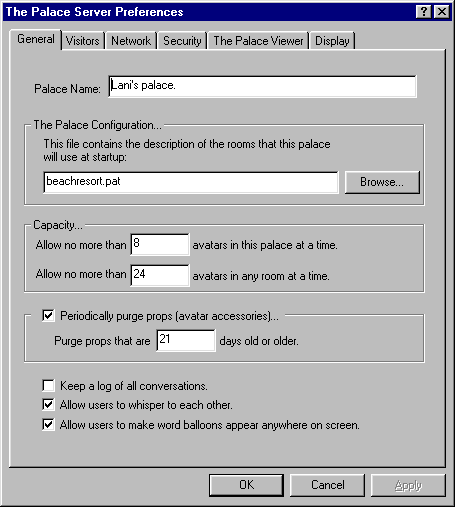
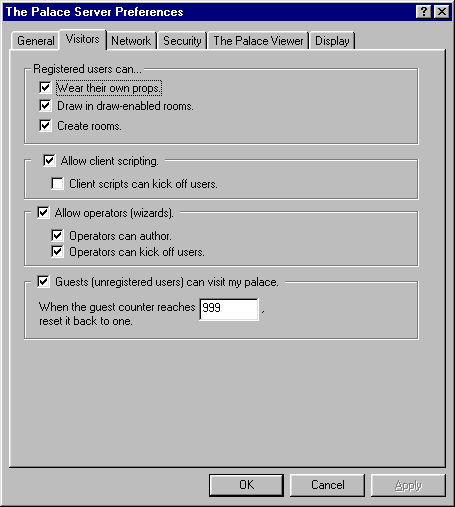
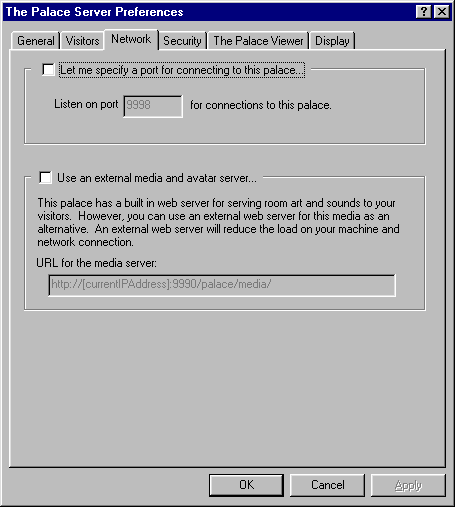
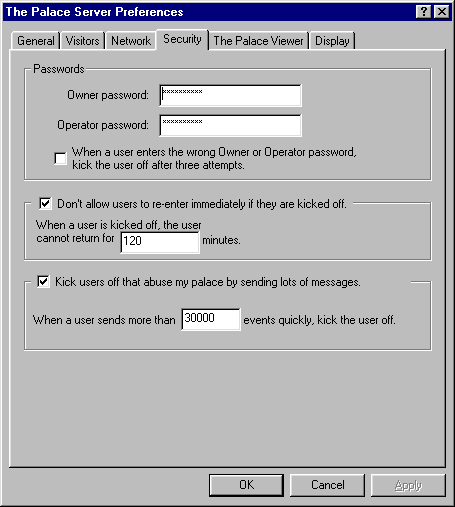

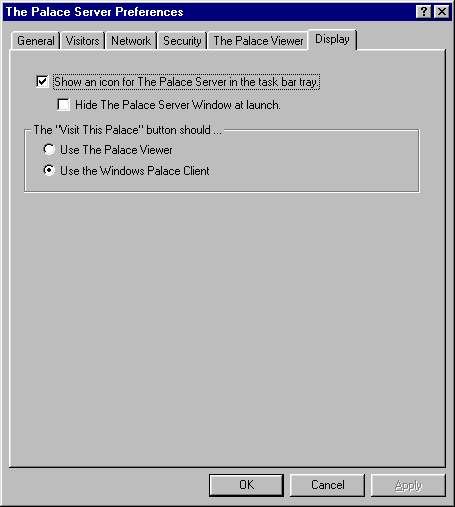
 del.icio.us
del.icio.us Digg
Digg
Post your comment